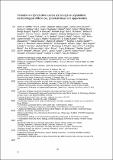Variation in reproductive success across captive populations : methodological differences, potential biases and opportunities
Abstract
Our understanding of fundamental organismal biology has been disproportionately influenced by studies of a relatively small number of ‘model’ species extensively studied in captivity. Laboratory populations of model species are commonly subject to a number of forms of past and current selection that may affect experimental outcomes. Here, we examine these processes and their outcomes in one of the most widely used vertebrate species in the laboratory – the zebra finch (Taeniopygia guttata). This important model species is used for research across a broad range of fields, partly due to the ease with which it can be bred in captivity. However despite this perceived amenability, we demonstrate extensive variation in the success with which different laboratories and studies bred their subjects, and overall only 64% of all females that were given the opportunity, bred successfully in the laboratory. We identify and review several environmental, husbandry, life-history and behavioural factors that potentially contribute to this variation. The variation in reproductive success across individuals could lead to biases in experimental outcomes and drive some of the heterogeneity in research outcomes across studies. The zebra finch remains an excellent captive animal system and our aim is to sharpen the insight that future studies of this species can provide, both to our understanding of this species and also with respect to the reproduction of captive animals more widely. We hope to improve systematic reporting methods and that further investigation of the issues we raise will lead both to advances in our fundamental understanding of avian reproduction as well as to improvements in future welfare and experimental efficiency.
Citation
Griffith , S C , Crino , O L , Andrew , S C , Nomano , F Y , Adkins-Regan , E , Alonso-Alvarez , C , Bailey , I E , Bittner , S S , Bolton , P E , Boner , W , Boogert , N , Boucaud , I C A , Briga , M , Buchanan , K L , Caspers , B A , Cichoń , M , Clayton , D F , Derégnaucourt , S , Forstmeier , W , Guillette , L M , Hartley , I R , Healy , S D , Hill , D L , Holveck , M-J , Hurley , L L , Ihle , M , Krause , E T , Mainwaring , M C , Marasco , V , Mariette , M M , Martin-Wintle , M S , McCowan , L S C , McMahon , M , Monaghan , P , Nager , R G , Naguib , M , Nord , A , Potvin , D A , Prior , N H , Riebel , K , Romero-Haro , A A , Royle , N J , Rutkowska , J , Schuett , W , Swaddle , J P , Tobler , M , Trompf , L , Varian-Ramos , C W , Vignal , C , Villain , A S & Williams , T D 2017 , ' Variation in reproductive success across captive populations : methodological differences, potential biases and opportunities ' , Ethology , vol. 123 , no. 1 , pp. 1-29 . https://doi.org/10.1111/eth.12576
Publication
Ethology
Status
Peer reviewed
ISSN
0179-1613Type
Journal article
Collections
Items in the St Andrews Research Repository are protected by copyright, with all rights reserved, unless otherwise indicated.

